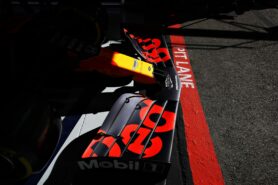Vortex Generator

A detail shot of the front wing of the Red Bull Racing RB16 during practice ahead of the 2020 F1 Grand Prix of Portugal
Vortex generator: A vortex generator is a small, aerodynamic device that is typically made of carbon fiber and is used on Formula 1 racing cars to manipulate the air flow around the car's body. The goal of the vortex generator is to increase downforce, which improves the car's grip on the track and allows it to corner at higher speeds.
How it works: Vortex generators work by creating small, controlled vortices that help manipulate the airflow around the car's body. By creating these vortices, the device can help delay the separation of the boundary layer, which is the thin layer of air that adheres to the surface of the car's body as it moves through the air. This delay in separation reduces drag and increases downforce, which improves the car's overall performance.
Placement: Vortex generators are typically placed on the car's front wing, which is the primary source of downforce for the car. They can also be placed on other parts of the car's body, such as the rear wing or the sidepods, to further enhance the car's aerodynamics.
Design: Vortex generators come in a variety of shapes and sizes, and their design is often customized for each individual race track. The angle and orientation of the device can also be adjusted to optimize its performance depending on the conditions on the track.
Overall, vortex generators are a critical component of a Formula 1 car's aerodynamic design. By creating small vortices that manipulate the airflow around the car's body, these devices help increase downforce and improve the car's grip on the track, ultimately leading to faster lap times and better race performance.











LAST 3 F1 Fan COMMENTS